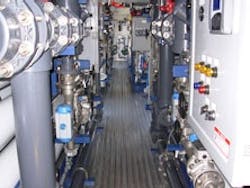The Ameren Coffeen Power Station in Coffeen, Ill., draws its water from a man-made 1,100-acre lake, which also boasts more than 20 species of fish and provides recreation for anglers, boaters, campers and hunters. The lake’s watershed has a relatively small amount of land area, and the power station utilizes the lake for condenser cooling as well as makeup for boiler feed water. As a result, the water component of the ecosystem is essentially a large closed-loop system. Seasonally, the lake level can vary significantly. Particularly challenging are long, dry, hot summers, which lower the lake level and result in higher concentrations of dissolved solids.
The power station’s water treatment system was aging, and the station wanted to replace it with one that could handle turbidity spikes and total organic carbon, silica and sodium levels in the lake water. The plant also wanted to minimize the amount of regeneration chemicals discharged to the lake. It needed a treatment system that was not only reliable, with maximum uptime, but one that would produce the required quality and quantity of water while reducing plant costs and maintenance time.A Better Fit
The station chose an innovative, containerized system design from Siemens that used microfiltration (MF) and high-flow-rate reverse osmosis (RO) technology. Because the MF technology is 30% smaller than conventional treatment technology, the system could be housed in a container that fit the power plant’s limited space and eliminated the need to build a separate building to house the equipment.
MF was also 40% less expensive than conventional technology. The system’s skid-mounted design allowed easy installation versus having to construct steel or concrete clarifiers on site, thus reducing the construction time. To meet the power station’s need for treated water while the new system was being built, Siemens deployed a temporary mobile water treatment system to the site. This system included a mobile pretreatment trailer consisting of duo-media; two combo RO trailers , which contained multimedia filtration and RO; one mobile deionization (DI) trailer ; and two skid-mounted FlexTrex deionization vessels for polishing the product water after the DI trailer.
The long-term treatment system, which took six months to design and build, was implemented in February 2009, replacing both the old treatment system and the temporary mobile system. In this 300-gal-per-minute system, lake water is first treated with sodium hypochlorite for disinfection, and then with four MEMCOR XP pressurized membrane systems . The water is then sent to a storage tank. After sodium bisulfite and antiscalant injection, the water enters the first-pass RO system. The system also has the capability for sodium hydroxide to be injected into the water to convert carbon dioxide to bicarbonate for removal in the RO. A primary set of portable DI exchange vessels polishes the RO water, and a final set of portable DI exchange vessels further polishes the water to an even higher level of purity. Everything is tied together with a single controller via a remote I/O network.
Above and Beyond
The system has been reliable thus far and has exceeded the product water specifications. The power plant has saved on operating costs by reducing chemical usage. The amount of chemicals discharged to the lake has been reduced by approximately 35%, and plant maintenance has been reduced by approximately 3,000 man-hours per year. The system is owned by Siemens and operated and maintained by personnel from the local Siemens branch office. The quantity and quality of the water is guaranteed for the life of the contract.
